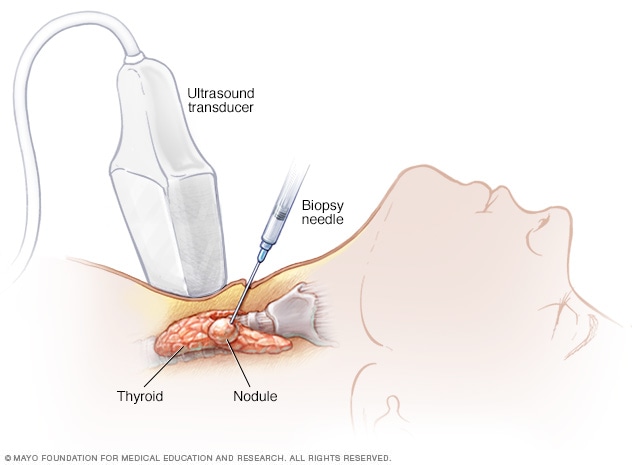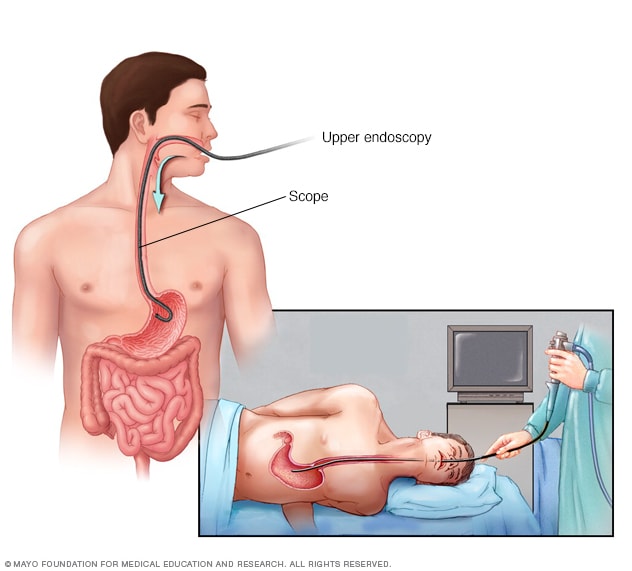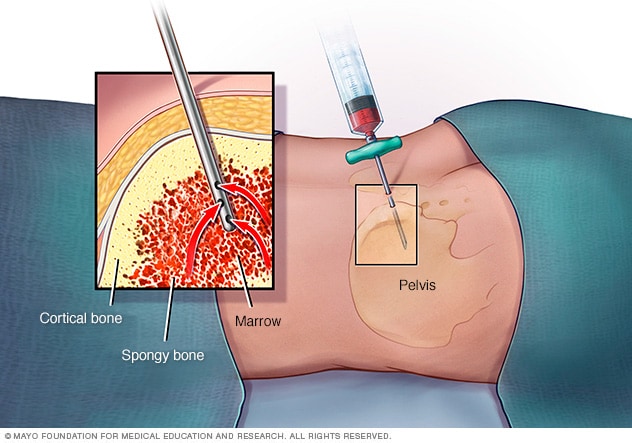Biopsy: Types of biopsy procedures used to diagnose cancer
A biopsy can help determine if you have cancer or another condition. Learn about the different types of biopsies and what to expect.
By Mayo Clinic Staff
A biopsy is a procedure to remove a piece of tissue or a sample of cells from your body so that it can be tested in a laboratory. You may undergo a biopsy if you're experiencing certain signs and symptoms or if your health care provider has identified an area of concern. A biopsy can determine whether you have cancer or another condition.
Imaging tests, such as CT scans or MRIs, are helpful in detecting masses or irregular tissue, but they alone can't tell the difference between cancerous cells and cells that aren't cancerous. For most cancers, the only way to make a diagnosis is to perform a biopsy to collect cells for closer examination.
Here's a look at the various types of biopsy procedures used to make a cancer diagnosis.
Needle biopsy
Needle biopsy
Needle biopsy

Needle biopsy
During needle biopsy, a long, thin needle is inserted through the skin and into the suspicious area. Cells are removed and analyzed to see if they are cancerous.
Needle biopsy is a general term that's often used to describe inserting a special needle through the skin to collect cells from a suspicious area. Doctors call this a percutaneous tissue biopsy.
A needle biopsy is often used on suspicious areas that your health care provider can feel through your skin, such as breast lumps and enlarged lymph nodes. When combined with an imaging procedure, needle biopsy can be used to collect cells from an area that can't be felt through the skin.
Needle biopsy procedures include:
- Fine-needle aspiration. During fine-needle aspiration, a long, thin needle is inserted into the suspicious area. A syringe is used to draw out fluid and cells for analysis.
- Core needle biopsy. A larger needle with a cutting tip is used during core needle biopsy to draw a column of tissue out of a suspicious area.
- Vacuum-assisted biopsy. During vacuum-assisted biopsy, a suction device increases the amount of fluid and cells that is extracted through the needle. This can reduce the number of times the needle must be inserted to collect an adequate sample.
Image-guided biopsy. Image-guided biopsy combines an imaging procedure — such as a CT scan, MRI or ultrasound — with a needle biopsy.
Image-guided biopsy allows your health care provider to access suspicious areas that can't be felt through the skin, such as on the liver, lung or prostate. Using real-time images, your health care provider can make sure the needle reaches the correct spot.
You'll receive a local anesthetic to numb the area being biopsied to minimize the pain.
Endoscopic biopsy
Endoscopy
Endoscopy

Endoscopy
An endoscopy procedure involves inserting a long, flexible tube (endoscope) down your throat and into your esophagus. A tiny camera on the end of the endoscope lets your doctor examine your esophagus, stomach and the beginning of your small intestine (duodenum).
During endoscopy, your health care provider uses a thin, flexible tube (endoscope) with a light on the end to see structures inside your body. Special tools are passed through the tube to take a small sample of tissue to be analyzed.
What type of endoscopic biopsy you undergo depends on where the suspicious area is located. The endoscope can be inserted through your mouth, rectum, urinary tract or a small incision in your skin.
Examples of endoscopic biopsy procedures include cystoscopy to collect tissue from inside your bladder, bronchoscopy to get tissue from inside your lung and colonoscopy to collect tissue from inside your colon.
Depending on the type of endoscopic biopsy you undergo, you may receive a sedative or anesthetic before the procedure.
Skin biopsy
Punch biopsy
Punch biopsy

Punch biopsy
During a punch biopsy, your health care provider uses a special circular blade to remove deeper layers of skin for testing. Depending on the size, stitches may be necessary to close the wound.
A skin biopsy removes cells from the surface of your body. A skin biopsy is used most often to diagnose skin conditions, including melanoma and other cancers. The type of skin biopsy you undergo will depend on the type of cancer suspected and the extent of the suspicious cells.
Skin biopsy procedures include:
- Shave biopsy. During a shave biopsy, your health care provider uses a tool similar to a razor to scrape the surface of your skin.
- Punch biopsy. During a punch biopsy, a circular tool is used to remove a small section of your skin's deeper layers.
- Incisional biopsy. During an incisional biopsy, your provider uses a scalpel to remove a small area of skin. Whether you receive stitches to close the biopsy site depends on the amount of skin removed.
- Excisional biopsy. During an excisional biopsy, an entire lump or area of skin that appears suspicious is removed. You'll likely receive stitches to close the biopsy site.
Before the procedure, you'll receive a local anesthetic to numb the biopsy site.
Bone marrow biopsy
Bone marrow exam
Bone marrow exam

Bone marrow exam
In a bone marrow aspiration, your health care provider uses a thin needle to remove a small amount of liquid bone marrow, usually from a spot in the back of your hipbone (pelvis). A bone marrow biopsy is often done at the same time. This second procedure removes a small piece of bone tissue and the enclosed marrow.
Your health care provider may recommend a bone marrow biopsy based on your blood test results or if your provider suspects cancer is affecting your bone marrow.
Bone marrow is the spongy material inside some of your larger bones where blood cells are made. Analyzing a sample of bone marrow may reveal what's causing your blood problem.
A bone marrow biopsy is commonly used to diagnose a variety of blood problems, both cancerous and not cancerous. A bone marrow biopsy can diagnose blood cancers, such as leukemia, lymphoma and multiple myeloma. It can also detect cancers that started elsewhere and traveled to the bone marrow.
During a bone marrow biopsy, your health care provider draws a sample of bone marrow out of the back of your hipbone using a long needle. In certain situations, the sample can be collected from other bones in your body. You'll receive a local anesthetic or other medicine to minimize discomfort during the procedure.
Surgical biopsy
Your health care provider may recommend a surgical biopsy if the cells in question can't be accessed with other biopsy procedures or if other biopsy results have been inconclusive.
During a surgical biopsy, a surgeon makes an incision in your skin to access the suspicious area of cells. Examples of surgical biopsy procedures include surgery to remove a breast lump for a possible breast cancer diagnosis and surgery to remove a lymph node for a possible lymphoma diagnosis.
Surgical biopsy procedures can be used to remove part of a suspicious area of cells. Or surgical biopsy may remove all of the cells.
You may receive local anesthetics to numb the area of the biopsy. Some surgical biopsy procedures require general anesthetics to put you in a sleep-like state. You might need to stay in the hospital after the procedure.
Biopsy analysis and results
After your health care provider obtains a tissue sample, it's sent to a laboratory for analysis. The sample may be chemically treated or frozen and sliced into very thin sections. The sections are placed on glass slides, stained to enhance contrast and studied under a microscope.
The biopsy results help your health care provider determine whether the cells are cancerous. If the cells are cancerous, the results can tell your care provider where the cancer originated — the type of cancer.
A biopsy also helps your care provider determine how aggressive your cancer is — the cancer's grade. The grade is sometimes expressed as a number on a scale of 1 to 4 and is determined by how cancer cells look under the microscope.
Low-grade (grade 1) cancers are generally the least aggressive and high-grade (grade 4) cancers are generally the most aggressive. This information may help guide treatment options. Other special tests on the cancer cells also can help to guide treatment choices.
In some situations, such as during surgery, the sample of cells may be examined immediately and results are available to your surgeon within minutes. But most often, the results of your biopsy are available in a few days. Some samples may need more time to be analyzed. Ask your health care provider how long to expect to wait for your biopsy results.
Dec. 13, 2023
- Biopsy. American Society of Clinical Oncology. http://www.cancer.net/navigating-cancer-care/diagnosing-cancer/tests-and-procedures/biopsy. Accessed Oct. 14, 2021.
- Biopsy. National Health Service. http://www.nhs.uk/conditions/Biopsy/Pages/Introduction.aspx. Accessed Oct. 14, 2021.
- Types of endoscopy. American Society of Clinical Oncology. http://www.cancer.net/navigating-cancer-care/diagnosing-cancer/tests-and-procedures/types-endoscopy. Accessed Oct. 14, 2021.
- Biopsy. National Breast Cancer Foundation. http://www.nationalbreastcancer.org/breast-cancer-biopsy. Accessed Oct. 18, 2021.
- Fowler GC, et al., eds. Pfenninger and Fowler's Procedures for Primary Care. 4th ed. Elsevier; 2020. https://www.clinicalkey.com. Accessed Oct. 14, 2021.
- AskMayoExpert. Bone marrow aspiration and biopsy. Mayo Clinic; 2020.
- Alguire PC, et al. Skin biopsy techniques. https://www.uptodate.com/contents/search. Accessed Oct. 14, 2021.
- Ferrer RL. Evaluation of peripheral lymphadenopathy in adults. https://www.uptodate.com/contents/search. Accessed Oct. 25, 2021.
- Stages of cancer. American Society of Clinical Oncology. https://www.cancer.net/navigating-cancer-care/diagnosing-cancer/stages-cancer. Accessed Oct. 26, 2021.